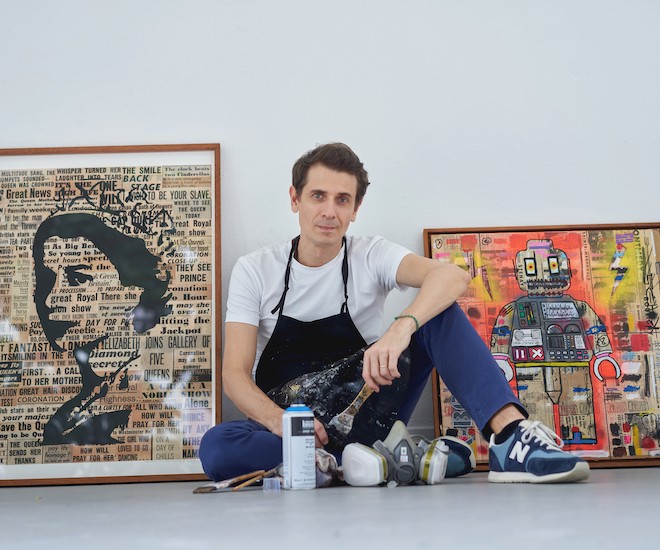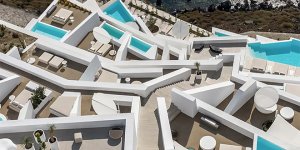Artist Gabriel Dufourcq: More Than Meets the Eye
“So, an artist is selfish because they have something they want to express and they make it happen through art.”

Looking at Gabriel Dufourcq’s artwork, you will inevitably have your focus on the icons that have been featured. But there is more than meets the eye because laying behind the iconic figure are newspaper headlines and original archives as old as 200 years, related to the political and pop icons. At first glance, an artwork presented to us may speak of our preconceived notions, but Dufourcq’s artwork invites us to inspect with greater detail questioning our established certitudes. Doing so, it could perhaps help to shed light by providing more information.
Chatting with Gabriel Dufourcq, the artist takes us through what it means to be an artist and how beyond his formal background in Economics and an MBA, his holistic approach to life stimulates his creativity and drive his pictorial and stylistic development.
You originate from France and you are now based in Singapore. Tell us about your first steps as an artist?
I don’t really think there are any first steps as an artist. It’s more like things gradually reveal themselves to you over time, and you ultimately end up creating something which others call “art”. If I recall, I feel the start lays in a sincere and profound need to create something, to give birth and reveal your inner self in one way or the other by connecting ideas and inspirations. Materalising an idea for an artwork is ultimately making space in your mind!
I’m originally from France but have spent the last 12 years in Singapore. After spending few years on the road starting in Madrid then Rome, followed by a couple of months in the Middle East and the Horn of Africa, I finally landed in Kuala Lumpur in 2007. The cultural diversity coupled with the intellectual excitement of being out of my comfort zone is something that also creates many “sparkles of creativity”. It is freeing the mind of your own stereotypes and allowing you to expand your own intellectual horizons. Discovering new flavours, colours, philosophies, mindsets, thinking and religious standards create a very fertile ground for the growth and the revealing of your artistic expression.
So like I said, there aren’t any “first steps”, it’s more like a spiritual journey, growing in the silence of our minds. I don’t have any formal Art education or training. Instead, I studied economics and statistics. One can go to school to study arts but ultimately, like entrepreneurs, an academic background is not what makes you! It took me years to call myself an artist. I didn’t want to self-proclaim as such. For me, this is a title to be won and should be given by others in recognition of your work. It is only when people start calling you “artist” that you know for sure you’re one.
Vintage newspapers, archive papers and bright pop-style colours are recurrent across your work. What led you to associate these rather opposite mediums?

Portrait Series, Queen Elizabeth, 120 x 80 cm
As I mentioned earlier, the creative process is gradual and therefore this came slowly to me as a real thought process. I started with simple newspapers collages and then began painting iconic elements onto them to create a dialogue — a parallelism between the background and the icon. In this way, we’re touching on the exact intentions of my work, which is to have a double-reading and provoke a reflection to the audience on these preconceived icons
My artworks require two layers of reading: First you have a very familiar pop icon, which is a straightforward visual element that can be easily repeated (the principle of Pop(ular) Art). Then there are the newspapers and archive documents I work with that could be 150-200 years old, and so the goal is to create a dialogue between historical elements and more contemporary elements. It is about bringing modernity to old memories or history into modernity. I try to incorporate a “back-to-the-future” element into my artwork and create dialogues between two very different time periods, the 21st century and 18th or 19th and 20th century.
For example, when I draw the Maharaja’s face in Fluo pink on an old Indian paper from the 19th century, the contrast of the dull documents and vibrant colours is really like travelling through time. Also, the value of these pieces stems not only from the actual art but the historical documents that are part of the artwork. These can cost thousands when I acquire them from auctions or antique collectors but are often just lying dormant in some library before I revive them using art.
Through my artwork, I aspire to open people’s eyes to history and remind them of where they come from. The question of origins is central in my work. It is especially important in the 21st century where we have mass production of Pop art icons, like Muhammad Ali or Marilyn Monroe. But no one knows really their full story, beyond a name or a function. In contrast, when I work on a portrait of Ali with 300 newspapers titles in the background, I am reviving all the elements that built the icon. When people see the portrait, everyone recognizes Ali but to truly get to know him you must dive into the background reading.
How do you choose the icons and personalities you are portraying in your artworks? What is your creative process like?

Portrait Series, Lee Kuan Yew, 120 x 80 cm
I started with political icons as I was fascinated with how these figures could become famous. Aside from 20th century dictators, I have been focusing on those universally known personalities like Mandela, Queen Elizabeth, Churchill, Kennedy and others.
In line with this series, I also portrayed Lee Kuan Yew as a tribute to Singapore, who helped with building and fixing the history of the country’s art scene, but also because Mr Lee‘s legacy is beyond the achievement of many global political leaders in my eyes.
That is how it started and then I gradually shifted to more popular icons like The Beatles and Muhammad Ali who also had tremendous social and political impact.
Keeping up with pop culture, in some ways, has deviated my artistic style of double-reading as it is now influenced by more commercial icons. But anyway, an artist shouldn’t be doing the same thing over and over… Consistency is important as I mentioned earlier, but collectors are expecting to see progression, evolution trajectory and ability to continuously evolve. Collectors do not want to buy another “Printing Machine” style artwork, and being an artist is also being able to explore new territories, different styles and techniques, expanding our own boundaries.
What is the most challenging part about creating your artwork?

The process of collecting and building historical archives is physically challenging and very time-consuming but that is not the hardest part. The most challenging part of creating art is the ability to judge yourself and ask, “Does my artwork deserve to be shown?”. I never ask my friends nor my family, because I want to avoid any complacency and false confidence. I usually keep an artwork to myself for a certain amount of time before releasing it publicly so that I can contemplate it alone in my home studio and take the time to judge what I created.
One of my favourite stories is The Little Prince. In the story, the Prince travels to seven planets before arriving on Earth. On the first planet he lands on, he is greeted by the sole inhabitant, a King, who makes him his Minister of Justice. The Prince remarks that there isn’t anyone else to judge on his planet and so the King asks him to judge himself. To this, the Prince replies, “that is the most difficult thing of all. It is much more difficult to judge oneself than to judge others. If you succeed in judging yourself rightly, then you are indeed a man of true wisdom.” And I absolutely agree with that.
More realistically the two major challenges I face are time constraints to create what I have accumulated in my notebooks and on papers, and secondly judging which of my artworks deserve to be shown out of the countless pieces I have created.
What emotions do you hope the viewers experience when looking at your art?

That’s the toughest question yet! I would love to be able to feel the emotions of my collectors when they look at my artwork. As an artist, I already know what my work means and what emotions it elucidates since it is by essence an expression of my inner self, mirroring a certain perception of my reality.
But I would like to feel what they truly feel, what catches their eyes, and what invites them to pause in front of the work and even to acquire it. In communication there’s always a difference between what one intends to say and what other hears and interpret. I feel this to be the same with art.
“Nothing touches a work of art so little as words: they always result in more or less fortunate misunderstandings. Things aren’t all so tangible and sayable as people would usually have us believe” — Rainer Maria Rilke
A work of art is good if it has arisen out of necessity. That is the only way one can judge it. On this note, my latest works from the series “Oedipal Disobedience” involve the use of mixed media. Robots in this series are painted in a post expressionist style, which are more complex to read and more open to individual interpretation. It is also the result of more mature thoughts and technical experimentations and countless influences.
I do not really believe that artists should impose their definition of what people have to feel or understand from their work. If your art is good enough, it will speak to people, but just let them appreciate it and form their own interpretations.
You have started a new series focusing on robots, tell us more about this new artistic venture?

As part of my artistic endeavour, it is a natural progression, pushing my boundaries and challenging myself with a new stylistic approach. In short, it is a fusion of my technicalities and different influences aiming to question our contemporary purpose and trajectory. In many of my works, I include the math equation from Chaos Theory, inspired by my economics and statistics background. The theory’s fundamental conditions fascinate me as it is the start and end of everything. It echoes my religious influence when I include Greek symbols of Alpha and Omega, which represent eternity.
These robots are an invitation to contemplate, and self-reflect on what the future looks like, and how robots could replace or complement humanity. The shape and size of my robots are remastered version of religious effigies, like those used by the Incas and in Voodoo. My robots are acting as the religious effigies of this 21st century, the new totems of the Digital Age.
What is the role the artist plays in society?
I am not sure that artists must own a specific role in society; a very fixed and constrained concept. I mean a limited time frame conditioned by norms and bias. The artistic condition is before all a self-centred necessity to explore our innermost feeling. I am no one to impose my thoughts on others. If people find a common message in my work, it is great that it has contributed to their own reflections. But artists by themselves have no specific role, their works might have one by contributing beyond the temporality of the artist.
When creating, I simply bring to my own life and the light I want to see in the world. It is a bit similar to Gandhi’s quote, “be the change you want to see in the world.” I create what I would like to see.
In fact, an artist should just provide an escape, a dream state for others to plunge into and feel at peace, inspired, as they enjoy the art piece. As a final point I’d like to share one of my motto in life: Who are my creative irritators and to whom am I a creative irritator? If it is not the universal artist role, it is at least my guiding principle…
How is Singapore inspiring you in your daily life and in your personal evolution as an artist?
My journey in Southeast Asia started 14 years ago and has been a steep learning curve since. I was not an “artist” when I landed here. And I would have probably never been if I had stayed in Europe. Loneliness, away from my native country, has been an eye opener from a cultural, religious, historical point of view. Singapore’s multicultural diversity has been a true accelerator, fuelling the sparkles of creativity in my mind. Even after 12 years, every day here is a new opportunity of discovery and questions. Recently I really liked this statement I came across on a public advertising in the train: “Singapore is not boring, you are boring.” I simply cannot understand why people find Singapore boring. There are so many flavours, colours, and diversity here! It is a constant effervescence that offer you so many opportunities. Some people made use of the opportunities to start their own businesses and start-ups, I used it to become an artist.
The five words that best describe your art?
Introspection, personal need, meticulous, lonely, combination.
Tell us about your major projects and highlights across 2021?

Portrait Series, Obama, 120 x 80 cm
Covid-19 affected many of my recent projects. I was supposed to do an art fair in New York a few months ago and an exhibition in Paris back in March. Looking at the positive side, I have been focusing on maturing my style and creating new works that are well received by my collectors and the public.
The next big milestone will be toward my robot series. I feel I am at the beginning of a journey with something big at the end. Also, I’m currently finishing a residence at Intercontinental Hotel in Bugis and planning to attend the Singapore Affordable Art Fair this coming November (if restrictions are lifted). By 2022, we are planning some bigger things overseas mostly in the US, London, and Paris so stay tuned!
How can the LUXUO and ART REPUBLIK readers purchase an artwork from you?

For the latest releases, head over to my Instagram or my website, then contact me via WhatsApp or email. I ship my works worldwide, from Singapore to Rio de Janeiro and Johannesburg to London. It is very important for me to have a personal connection with every collector, even briefly; to chat and advise them on the different pieces, their stories and thought processes. Buying an artwork, it is before all buying a part of the artist story and thought process. It also allows my collectors to be my creative irritators, sometimes bringing to life new works, as a collaborating effort.
If you were to name one mentor who has inspired you in your life and path as an artist, who would that be?
I don’t have just one! There are plenty of people who gave me fantastic pieces of advice along my journey or supported me, from my mother to my wife but also many friends or even unknown people. My childhood as well as my life experiences, have been significant sources of inspiration, making my art almost a form of psychotherapy.
If pressed, perhaps one mentor I would highlight would be Michael Brimm, an INSEAD teacher during my MBA, who gave me the words I used earlier of “creative irritator”, advising us to identify who are these creative irritators in our lives. It has been a guiding principle since.
To follow Gabriel Dufourcq’s artworks, head over to his website or you can also follow his Instagram here: @gabrielsg_art.
By Joseph Low







